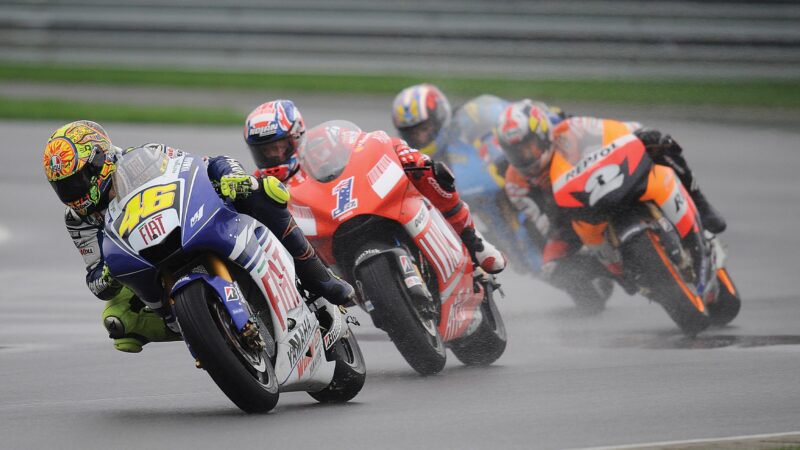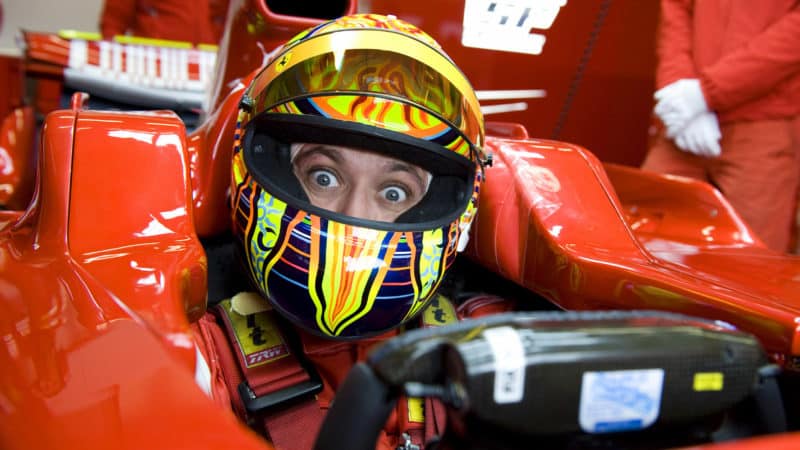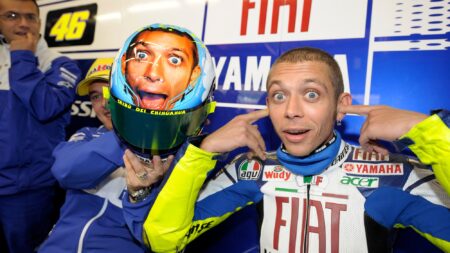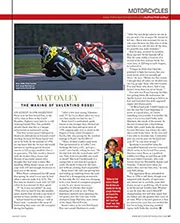Rossi enjoyed getting to grips with the unique demands of an F1 car but finally realised that what held true when he was a kid still holds true today: he wasn’t getting as much fun out of driving the Ferrari as he got from riding his Yamaha. Enjoyment is at the heart of everything Rossi does. His greatest strengths are an astonishing natural talent, a fierce, creative intelligence and a tireless dedication to his cause, but a sense of fun is also central to what he does. More than anything, Rossi goes racing for the love of it, for the buzz of it, and ultimately he didn’t enjoy driving the Ferrari enough. It didn’t light his fire.
“”With the Formula 1 car the driving becomes a bit unnatural, a bit different from a normal car. It is very important to understand how the aerodynamics work. A MotoGP bike is like a normal bike, but lighter, more power, more everything. A Formula 1 car is not like a normal car; you have to understand all about the wings, the braking is very different, everything is different. And then there is the traction control. The traction control worked very much and that’s what I didn’t like.” Ironically, F1 has now banned traction control, while anti-spin technology has become an overriding influence in MotoGP, something you won’t be surprised to learn aggravates Rossi intensely. He is one of several riders to have lobbied MotoGP bosses to exorcise electronic rider aids and return control to the human.
Motor sport is a bewitching mix of art and science, man and machine; that surely is one of its greatest attractions. In F1 Rossi felt that he was not a big enough part of the equation. He is an artist by temperament, not a dour race track scientist, which is why people love him. “It is true that in MotoGP we already have a lot of technical meetings in the team, a lot of thinking. I speak a lot about electronics with my guys, but in cars it is different. With cars, everything is already fixed, so if you do this, you make this lap time, if you add that fuel, you make that lap time. So it is like the driver doesn’t have anything to invent. It’s more like a job.”

Rossi heads Casey Stoner and Dani Pedrosa to one of his great wins at a sopping Indy this year
That isn’t to say that Rossi doesn’t like a challenge and a bit of hard work. Five years ago he quit Honda when the company’s RC211V was comfortably the best bike on the MotoGP grid and defected to Yamaha, then at its lowest ebb, without even taking a pay rise. “Maybe my choice seems a little bit crazy,” he said at the time, before turning Yamaha’s YZR-M1 from pitlane joke into race winner in just a few months. He left Honda because he felt the company’s racing bosses put too much emphasis on the machine and not the man. By winning on the Yamaha he proved them wrong. He proved that he was the bigger part of the equation.
“I like cars and I hope to have 10 years of extra career in cars when I stop with bikes”
The Rossi/Ferrari romance began soon after Rossi had joined Yamaha, when he was invited to test at the company’s Fiorano test track in the spring of 2004. Ferrari’s reigning F1 champ Michael Schumacher was present and impressed. Later that year Ferrari president Luca di Montezemolo pronounced: “There will always be an open door for Valentino at Ferrari.”
The following summer the then Ferrari technical director Ross Brawn announced that Rossi would test with the team once a month throughout 2006, presumably with a view to an F1 race debut in ’07 or ’08. In November 2005 Rossi got to test the Ferrari at a real race track for the first time, lapping Mugello fast enough for Ferrari to reserve him a place at the Valencia pre-season tests in January 2006, alongside the rest of the F1 grid — Alonso, Schumacher, Raikkonen et al. In the meantime he beat Colin McRae in the Monza Rally and took 11th place in Rally New Zealand.






